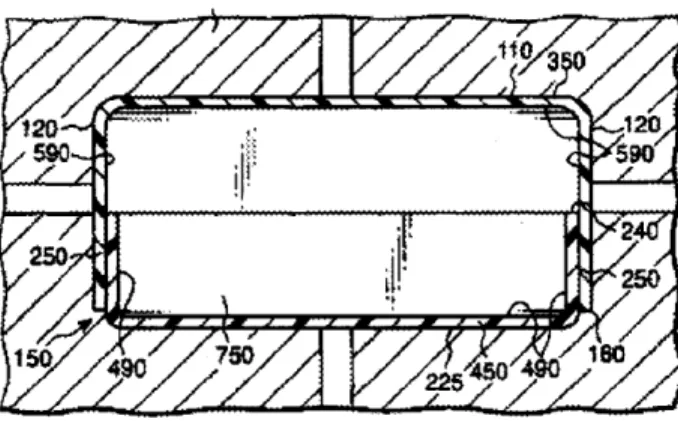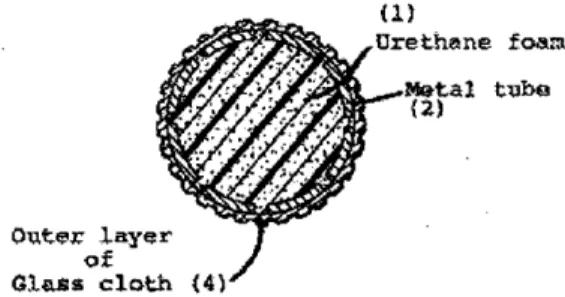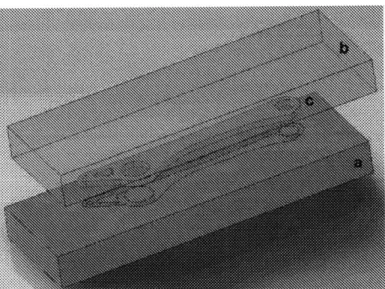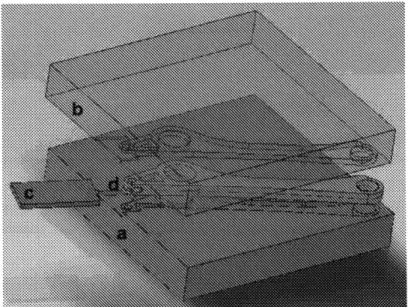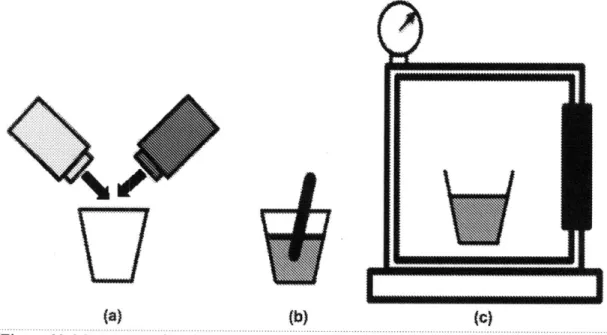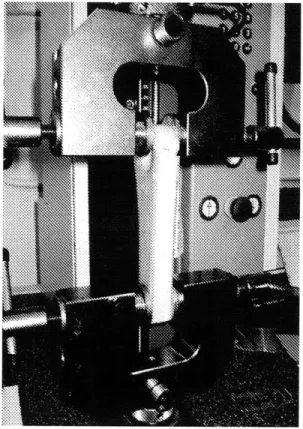Development of Manufacturing Technique for Composite Structures for Robotic Applications
by Theresa Dixon
Submitted to the Department of Mechanical Engineering in Partial Fulfillment of the Requirements for the Degree of
Bachelor of Science in Mechanical Engineering
at the
Massachusetts Institute of Technology June 2010 C 2010 Theresa Dixon
ARCHIVES
MASSACHUSETTS INSTITUTE OF TECHNOLOGYJUN 3 0 2010
LIBRARIES
All rights reservedThe author hereby grands MIT permission to reproduce and distribute publicly both paper and electronic copies of this thesis document in whole or in part, in any medium now known or
hereafter created.
Signature of Author...
Department of Mechanical Engineering May 17 010
Certified by... ...
A + professor of Mechanical Engin ring Thesis Supervisor
Accepted by...
John H. Lienhard V -oanms Professor of Mechanical Engineering Chairman, Undergraduate Thesis Committee
Development of Manufacturing Technique for
Composite Structures for Robotic Applications
by
Theresa Dixon
Submitted to the Department of Mechanical Engineering
on May 17, 2010 in Partial Fulfillment of the
Requirements for the Degree of Bachelor of Science in
Mechanical Engineering
ABSTRACT
An experimental study was performed with the aim of developing a technique for manufacturing
composite parts for use in dynamic robotic applications in lieu of heavy and expensive metal
parts used in conventional robotic systems. There is already a wide usage of sandwich board
materials in load bearing applications, but these do not provide equal strength in all directions,
particularly compressive strength. Additionally, these materials are only available in
two-dimensional shapes. The process developed over the course of this project seeks to make a fully
covered composite of any desired geometries. The specific robotics project addressed was the
hyper dynamic quadruped robotic platform, which ultimately seeks to design and construct a
robot capable of a high speed gallop. This thesis began exploring methods of fabricating parts
for one of the legs of the platform, specifically a radius part. Manufactured components needed
to be both light in weight to facilitate ease of movement for the robot and strong enough to
withstand the forces from the shifting weight during running. Proposed design parameters called
for a foam core with a hard plastic shell to meet these needs. This technique can lead to a
cheaper manufacturing method with a potential impact on the future robotics industry.
After an investigation into the properties of different liquid polyurethane foams and plastics, the
manufacturing techniques explored began with machining molds for both the inner core and
outer shell of composite parts into wax blocks. The project aims were to develop a prototyping
process, but this can lead to mass-production. Two versions of a manufacturing process with
these blocks were developed, one which uses an open mold and one which uses a closed mold.
Either method is viable for fabrication, with a preference for the open mold in parts with simple
geometry and small thickness, and for the closed mold in larger parts or ones with complicated or
interrupted outer perimeters.
Thesis Supervisor: Sangbae Kim
ACKNOWLEDGEMENTS
I would like to extend many thanks to Professor Sangbae Kim of the MIT Department of Mechanical Engineering for invaluable insight and assistance in completing this thesis. He provided support, suggestions, and guidance throughout the entire project, as well as the means for testing out the process once it was developed.
Additionally, special thanks go to Jake McKenzie for helping with the manufacture of the molds. His knowledge of how to translate solid computer models into solid tangible parts greatly facilitated the fabrication portion of the process.
Furthermore, I would like to thank Meredith Silberstein for lending her time and expertise to helping in setting up the preliminary materials testing for the results of the prototyping process.
TABLE OF CONTENTS
ABSTRA CT...2 A CKN OW LEDGEM EN TS... 3 Table of Contents...4 List of Figures...5 1 Introduction...6 2 Previous Research... 7 2.1 Composite M aterials... 72.2 Patented M anufacturing Processes... 8
3 M anufacturing Processes... 11 3.1 M old Design... 11 3.1.1 M old Variations... 13 3.2 M aterials Selection... 15 3.2.1 Foam ... 15 3.2.2 Plastic... 15
3.2.3 Introduction of Fiber Reinforcem ent... 16
4 Experim ents...17
4.1 Preparation of m ixtures... 17
4.2 M aterials Testing ... 18
5 Results and Discussion... 20
6 Conclusions...23
7 References...23
LIST OF FIGURES
Figure 1: Figure from U.S. Patent 5,744,077: "Method for Fabricating Composite Structure"...8
Figure 2: Figure from U.S. Patent 4,014,542: "Bat Used in Baseball"... 9
Figure 3. Figure from U.S. Patent 4,572,308: "Composite Laminated Baseball Bat"...9
Figure 4. Figure from U.S. Patent 5,173,227: "In-Situ Molding of Fiber Reinforced Composites to N et Sh ap e"... 10
Figure 5. Solid model of designed radius...11
Figure 6. M olding process... 12
Figure 7. Completed part in wax mold... 13
Figure 8. Exploded view of open mold model with details... 13
Figure 9. Exploded view of closed mold model with details... 14
Figure 10. Porous structure of different foam densities... 15
Figure 11. Mixing procedure for foam and plastic...17
Figure 12. Material testing setup... 18
Figure 13. Force-displacement graphs of composites... 19
Figure 14. Hardened mixture of plastic and glass fiber; 1:1 ratio... 20
1. Introduction
As the field of robotics research advances, machines begin to move autonomously over more challenging terrains utilizing legged locomotion. The future of research in dynamic robots is dependent on ensuring that the robots are both lightweight to facilitate ease of movement and capable of providing a structure capable of withstanding repetitive impacts on the ground. In this particular application, polymeric composite structure can provide better performance since light weight and impact resistance are more pertinent than stiffness.. Selection of materials answering these criteria is therefore vital. The purpose of this thesis project is to help further research in the hyper dynamic quadruped robotic platform, which seeks to model a running four-legged animal as a robot, by analyzing a new manufacturing method for the construction of components for robot legs. The aim of this study is to replace the expensive machining process of metallic materials. Aluminum parts provide excellent strength at given weight, but the machining process inherently increases the cost of manufacture. The fundamental motivation is to develop a manufacturing technique that allows light, robust, and cheap parts of arbitrary geometries.
A brief overview of existing research in the areas of composite materials behavior and previous patents for composite manufacturing processes is given in section two of this paper. This section also provides some insight as to the parameters set for the research project following. A description of the experimental procedures and methods leading up to the manufacturing procedure design is provided in section three. Some brief preliminary materials testing is outlined in section four. The results of testing on and examination of the manufactured parts and a discussion of the significance thereof are presented in the fifth section, and, finally, conclusions are listed in section six.
2. Previous Research
2.1 Composite Materials
Academic attention has been paid to sandwich beams in recent years as an alternative to metal parts and as a means of reducing vibrations in dynamic systems. They are particularly useful, as they feature materials of high specific strength and specific stiffness in applications of load-bearing structures as well as high shear resistance. By definition, a sandwich beam is a time of laminated composite material consisting of three layers, the outer two of which are the same, with a different inner core. These are all bonded to one another with the purpose of using the separate properties the different materials in conjunction [12]. Generally, the inner core is a lightweight porous material, which resists shear load, with rigid plastic or resin fiber outer layers, which resists in-plane loads.
Previous experimentation [19] of the flexure response of sandwich materials demonstrated a highly anisotropic response. The foam portion is particularly anisotropic between the in-plane and the through-thickness directions [22]. Bending tests confirmed that the specific strength and specific stiffness of the outer layers remain high [26].
A similar setup seemed desirable for this project, as the light weight of a foam inner core could be combined with the rigidity and stiffness of a hard plastic shell. The main novelty of this work is the focus on parts of arbitrary geometries; previous work deals only with beams. Developing a process for making different shapes can be beneficial in future for providing more insight as to the behavior of composites in non-trivial geometries. Additionally, most sandwich beams do not seem to be covered by plastic on all sides, which could partly account for the extreme anisotropic nature of the structure. More about some preliminary results of testing on the manufactured part will be given in later sections.
2.2 Patented Manufacturing Processes
Previously patented manufacturing processes for items made of composite materials generally fall into two types of categories. The first comprises of those that thermoform or injection mold the hard plastic outer layer and then fill the inner cavity with the core material. An example of this method is shown in figure 1 from U.S. Patent 5,744,077 by Grisch [6].
250 250
150 5 6
Figure 1. Figure
from
U.S. Patent 5,744,077: "Method for Fabricating Composite Structure" Using this method, the outer layer of the structure (labeled 120) is prefabricated and then rigidly held into place while the core material is injected in the inner space (labeled 750). An advantage of the project is the ability to closely control the shaping of the core, in that it is always rigidely held to the correct dimensions. A disadvantage, however, is the cost associated with injection molding or thermoforming the outer layers. These processes also involve multiple machines and processes prior to fabricating the actual part.The second category of common features of fabrication processes is forming the core material and then wrapping it in resin-impregnated reinforcing fibers. A simple example is in U.S. Patent 4,014,542 by Tanikawa [24], which presents a process for making a baseball bat (figure 2).
Urethane foam
Outer layar of
Glass Cloth (4)
Figure 2. Figure
from
U.S. Patent 4,014,542: "Bat Used in Baseball"Here, the foam is forced into the inside of a prefabricated metal tube, which is then wrapped in layers of glass cloth reinforced with resin. A similar pre-manufactured layering idea is used in U.S. Patent 4,572,308 by You [27], which fits wooden pieces together with layers of resin reinforcement in between, with the aid of dovetails (figure 3).
13,
15
15
15
Figure 3. Figure
from
U.S. Patent 4,572,308: "Composite Laminated Baseball Bat"Using a procedure comprising of only wrapping is inconvenient and time-consuming in this application, as well as potentially messy. An advantage is the simplicity of the method, which could potentially be used for only making the outer layers of the part, as presented in the next procedure discussed. Besides the already mentioned disadvantages, this method does not allow for complicated geometries, as there is a risk of losing small details in the multiple layers.
In a more automated process, Ewen [4] developed a method which involved injecting foam into an expandable mold cavity which was pre-lined with layers of resin impregnated fiber reinforcement (figure 4).
Figure 4. Figure
from
U.S. Patent 5,173,227: "In-Situ Molding of Fiber Reinforced Composites to Net Shape"After the core hardens, the fiber plies are heated while still in the mold, which hardens the resin around the desired shape. Advantageously, the procedure is fairly automated, involving little handling of the unfinished part in between layers. Handling carbon fiber cloth, or multiple layers of any other reinforcing material, however, does not seem desirable for the size of the components needed for the robot, both because the space needed far exceeded the size of the part, and because intricacies of part geometry might be lost in wrapping. The scale of the project also did not seem to warrant the mess and safety issues associated with making parts out of these materials. Additionally, the procedure seems expensive, and there is an increased risk in this system, as there are multiple moving and heating elements which could malfunction during fabrication.
The goal of the developed manufacturing process, therefore, was to attempt to combine elements of these types of existing processes: directly forming both the inner core and the outer shell, without needing to injection mold/thermoform, or wrap fiber layers.
3. Manufacturing Procedures
The proposed design for the structure of the composite components was a foam core with a fiber-reinforced plastic outer shell, combining the light weight of the foam with the stiffness and strength of the reinforced plastic. The procedure detailed herein accomplished this with two molds, sized differently for the two layers.
3.1 Mold Design
For the purposes of this project, the specific component used was the radius from the preliminary design of a robotic cheetah, as it was the simplest geometry in the model (figure 5).
Figure 5. Solid model of designed radius
The basic process for manufacturing this part as a composite structure involves nine steps, which are detailed below:
1. Machine a mold the size of the foam core of the composite material (figure 6a). Wax was chosen as the medium for making molds in this procedure, as it is soft. The parts could be easily machined and chipped out after they had solidified, and the molds for the different material
layers could be machined onto the same block of wax, one on top of the other if necessary. 2. Pour the core(figure 6b). It is important to have small features protruding from the core portion of the mold, as these are used for positioning the foam part within the shell mold later on. These can either be machined into the wax mold; or, they can be manually attached to the foam after it sets. In the first case, the feature material is that of the core, while in the second it is the same as that of the shell.
4. Machine the wax to the size of the full part, and position the core part into the mold for the shell. The "posts" around the foam are useful for this, in that they provide the appropriate standoff from the bottom and sides of the larger mold. This preserves the uniformity of the thickness of the plastic shell, providing the same structural support in all directions.
Use extra spacer molds around the sore as necessary to the desired part geometry (figure 6c). 8. Mix and pour plastic into the shell portion of the mold (figure 6d). Details on the specific material used for the plastic shell are provided in the materials selection section.
9. When the plastic has set, machine out the composite part.
(a)
(b)
(c)
(d}
A picture of the molds used in a real test fabrication is shown in figure 7.
Figure 7. Completed part in wax mold (open mold)
3.1.1 Mold Variations
This process can be used in either an open mold or a closed mold variation. In the open case, there is only one mold used, which is the entire thickness of the part (figure 8). The levelness of the exposed portion can be ensured by pressing down on the filled mold as the material sets, or by machining off extra material after it is solid with a facing operation.
Figure 8. Exploded view of open mold model with details (a)machined mold; (b)flat cover plate; (c)resulting poured part
Alternatively, the closed option involves making two molds, both of which are half the thickness of the finished part (figure 9).
Figure 9. Exploded view of closed mold model with details (a)machined mold bottom; (b)machined mold top; (c)spacer part to make cut away feature; (d)resulting poured part
An advantage of using this method is that, if necessary, multiple molds can be used in this method, depending upon the specific geometry of the part in question. In the radius model, there was a cut out feature in the thickness of the rounded triangle end. In order to add in this slot, the mold was modified to accommodate an extra piece of spacer material, which can be inserted during the pouring and curing processes. Once the poured material has hardened, the spacer can be removed. In order to minimize the risk of the spacer getting stuck, it is recommended that a piece of wax be used, as it can also be easily chipped away or broken if necessary.
3.2 Materials Selection
3.2.1 Foam
The foam used in the core of the radius was rigid polyurethane, composed of a mixture of polyurethane polyol (phenylisocyanate) and polymethylene plyphenyl isocyanate. (A more detailed look at the mixing process is in the experiment section.) There are a variety of foam densities available for use from the Smooth-On Foam-iT!@ series [28]; these were tested and compared with one another to determine the best one for the project before pouring into the core mold. 10 grams each of 8, 10, and 15 pounds per cubic foot density foam mixtures were allowed to set and then examined for differences in volume and microstructure. None of the mixtures showed any appreciable difference in volume from the others.
The 10 lbs/ft3 was ultimately chosen for the prototyping process as one which might be a trustful sample.
(a)
(b)(c)
Figure 10. Porous structure of diferent
foam
densities: (a)8 lbs/fl; (b)10 lbs/ft; (c)J5 lbs/ft13.2.2
Plastic
Similar to the foam, the plastic shell was composed of a urethane casting resin mixture of phenylisocyanate and polyurethane polymer. There are also variations of this material available for testing and comparing. The types tested here were a slow- and a medium-setting high performance liquid plastic (Smooth-On Inc. TASK@ series 2 and 4, respectively). Ultimately, the TASK 4 was chosen because of its longer pot life and handling time. Alone, it has a compressive strength of 7400psi and a tensile strength of 6500 psi [29].
An alternate shell material tested was epoxy. A comparison of the two materials is discussed in the experiments section.
3.2.3 Introduction of Fiber-Reinforcement
In order to provide extra structural support and to improve the tensile strength of the part, testing was also done in introducing fiber reinforcements to the hard plastic shell. One option explored was to add milled glass fiber to the plastic when it was first mixed.
Another option explored was adding a layer of carbon fiber cloth, similar to some of the patent literature discussed previously. Instead of adding an extra layer of resin and curing and hardening the fabric in that way, the layer was simply introduced around the outside of the foam part when it was placed in the shell mold, and the plastic was poured around it. This eliminated the need for handling resin chemicals, and the presence of only one layer meant that there wasn't any added bulk between the foam and the plastic. The carbon fiber provided reinforcement in two dimensions, not three. This makes the reinforcement options selective about the desired directions.
4. Experiments
4.1 Preparation of Mixtures
The mixing procedures for the foam and plastic materials were similar to one another. The process can be seen in figure 11.
(a)
(b)
(c)
Figure 11. Mixing procedure
for foam and plastic
First, the two components of the desired material - which come in liquid form - are poured
into a cup (figure 11la). In the foam case, the phenylisocyanate to polymethylene plyphenyl isocyanate ratio is 1:1 by weight, except the 8 lbs/ft3 case, which calls for a 2:1 ratio. For the
plastic, the phenylisocyanate to polyurethane polymer ratio by weight is 1:1 for TASK 4 and 12:10 for TASK 2. For testing purposes, the desired weight was 10 grams. After being poured together, the liquids are mixing vigorously, which an emphasis on ensuring that neither gets stuck on the side of the cup (figure 1lib). By this time, the foam mixture will already be expanding and transitioning to a spongy texture. The plastic mixture will have begun to thicken. Next, the mixture is degassed until air bubbles stop rising to the surface (figure 11 c). When it is taken out, the foam will already be nearly hardened, as the pot life for all three varieties tested is 1.5 minutes [28]. The pot life for the TASK 2 is 7 minutes, while that of the TASK 4 is 20 minutes
In order to add the fiber reinforcement to the shell layer, the milled glass fiber was simply added to the cup as the liquid plastics were being poured. From there, the mixture was stirred and degassed as in the normal procedure.
4.2 Materials Testing
In order to try to model some of the forces the radius would potentially see during running, the test parts were fixed in a material testing machine such that the forces would be applied along its length. The setup shown in figure 12 was used to conduct some simple tests on fabricated test parts in order to get an idea of the material properties of the produced composites.
Figure 12. Material testing setup
For purposes of preliminary comparison, both epoxy- and plastic- shelled parts were tested. Both parts had already broken before they were tested, and because of the different positions of the breaks they were tested with different exposed lengths. The plastic part length from mount to mount was 88mm, while that of the epoxy part was 97mm.
Figure 13 shows the results of tension tests conducted with the setup shown. In these tests, both parts were stretched at a rate of 0.0097mm/s until they made a sound as if they were about to break. Additionally, the epoxy part was tested a second time until it actually did crack.
1000 800 600 400 200 1 Plastic Shell -3 Epoxy -....-. 5 Epoxy break 0 -0 0.2 0.4 0.6 0.8 1 Displacement (mm)
Figure 13. Force-displacement graphs of composites
From the collected data, the stiffness of the plastic was found to be 1120N/mm, with a fracture force of 1010N. For the un-cracked epoxy, the stiffness was 1480N/mm. For the already-cracked epoxy, the stiffness was 1400N/mm. The epoxy part's fracture force was 930N. The cross-sectional areas of the plastic and epoxy parts were each approximately 470 mm2
5. Results and Discussion
As aforementioned, the original intent of the project was to reinforce the plastic shell layer for extra structural support and strength. The first method proposed for accomplishing this was to add milled glass fiber with the plastic mixture before pouring into the mold at an approximately 1:1 ratio. The resulting material was too viscous to pour and formed clumps (figure 14), around the boundaries of which it was easy to snap the plastic.
Figure 14. Hardened mixture ofplastic and glass fiber; 11 ratio
Changing the ratio of plastic to fibers with a lessened amount of fibers did not completely solve the problem, as the two components seem to have reacted with one another. This reaction caused the microscopic pieces of glass fiber to weaken and become irregular in structure, giving the frayed "fuzzy" look when the plastic was bent until it broke. This left the plastic mixture soft and flexible hours after it was meant to have hardened; and, in fact, it was weeks before the part completely cured.
As an alternative method for strengthening the shell, a layer of carbon fiber cloth was introduced around the foam core before pouring the plastic. Its addition provided a significant improvement in strength to the part.
Both of the discussed molding processes are viable for manufacturing composite parts with the desired parameters. The open mold method is useful in that one only needs to make one mold. This is disadvantageous, however, in that the mold depths need to be the full thicknesses of the finished parts, which means that the parts are deeply set into the wax. This leads to added difficulties when extracting from the wax and leads to further risk of breaking the part in the process. As previously mentioned, the open mold method is most practical for simple geometries, preferably those which have a simple perimeter. It is also easy to pour liquid
material into open molds, as well as to ensure that crevices are filled with the material. One alternative to using a covering plate in manufacturing a part with the open mold method is to simply leave it with an open face when pouring the foam and then machine down the extra material as it expands over the mold surface. A potential risk here is that the machined face of the part may be weaker than the bottom face, which has a more uniform and smoother surface finish.
The closed mold method means machining an additional set of molds, which can be cumbersome to position in relation to one another. Modeling and machining need to be especially careful, as small errors in these can lead to part halves which do not align. Closed molds are also more difficult to fill, as one cannot see all the crevices with may remain unfilled. Positioning of the flow paths, therefore, needs to be done strategically, to ensure that material will be forced into the corners most unlikely to be reached with a simple flow. Some of the disadvantages of the open mold method are mitigated or eliminated in the closed method, such as the added risk of a mold with a depth of the full part thickness. The closed mold halves each contain half of the part thickness, but demolding can be challenging if one or both gets stuck in the wax. Added protruding post features, such as previously discussed, are thereby an important means of ensuring that the chances of sticking are lessened. Flow channels and spacer features can also become a way to pry open the molds. The main advantage of the closed mold is the ability to construct parts of more complicated and irregular geometries. The mold halves do not need to be symmetrical as they are here, and spacer components may be easily inserted where they are needed.
Figure 15. Completed composite radius part
As can be seen, this particular test part has a carbon-fiber reinforced perimeter. The weight of the completed part was around 120 grams, with an estimated foam weight of 40 grams and shell weight of about 80 grams. (A similarly-sized piece of sandwich board would be approximately 75 grams.)
The results of the tension tests showed that the plastic test part had a higher fracture force, while the epoxy had a higher stiffness. However, both parts were structurally comprised when these tests were conducted: the plastic part had a section on its side with uneven covering, while the epoxy part may have already been cracked at one of its clamped ends. Additionally, it would have been preferable to run a compression test, as most of the forces on the running leg will be in that direction. However, the plastic shell was difficult to grip securely because of its smoothness, and there was the risk of slipping as the clamps moved. Attempts to sand the part for added friction were adequate for the tension tests, but were unable to facilitate successful compression tests. As aforementioned, both parts were already partially broken when they were tested, most notably at the circular end. Future testing could take advantage of this looped geometry as a
5. Conclusions
Manufacturing composite parts with a foam core and a hard plastic shell was accomplished by making wax molds and pouring first the foam and then the plastic. Two variations on this method were explored, one with an open mold and the other with two machined components making up a closed mold. Either manufacturing variation could be used in future robotic applications, depending upon the geometry of the part. The open mold variety is preferred for thinner parts with a simple perimeter. Larger and more complicated parts should be manufactured with the closed mold method. Comparisons to a similarly sized sandwich board showed that the manufactured part was heavier. As a critical feature of these parts is light-weight, future work should focus on attempting to standardize this. Future work should include much more rigorous testing of material parameters, as comparisons between plastic and epoxy shell test parts were inconclusive. Further quantities to test should include strength, impact strength, and strain energy, which can be compared to metallic parts of similar geometry. Additionally, it would be desirable to do further research into making molds of a different material, one which could perhaps be salvaged for multiple uses, as a lot of wax was wasted in extracting the parts. As the ultimate goal of the project would be to automate the process as much as possible, reusable molds would be useful to this end and would save cost.
6. References
[1] Alexander, R. McN. (1990). Three Uses for Springs in Legged Locomotion. The International Journal of Robotics Research; 9; 2: 53-61.
[21 Bertram, J.E.A. And Gutmann, A. (2008). Motions of the Running Horse and Cheetah Revisited: Fundamental Mechanics of the Transverse and Rotary Gallop. Journal of the Royal Society Interface 2008; 6: 549-559.
[31 Dawson, T.J. and Taylor, C.R. (1973). Energetic Cost of Locomotion in Kangaroos. Nature; 246: 313-314.
[4] Ewen, J.H., et al. "In-Situ Molding of Fiber Reinforced Composites to Net Shape." U.S. Patent 5,173,227. 22. December 1992.
[5] Farley, C.T. And Gonzalez, 0. (1995). Leg Stiffness and Stride Frequency in Human
[6] Grisch, W.E. and Massey, F.L. "Method for Fabricating a Composite Structure." U.S. Patent 5,744,077. 28. April 1998.
[7] Hill, A.V. (1953). The Mechanics ofActive Muscle. Proceedings of the Royal Society of London. Series B, Biological Sciences; 141; 902 (Mar. 11, 1953): 104-117.
[8] Josephson, R.K. (1993). Contraction Dynamics and Power Output of Skeletal Muscle. Annual Review of Physiology 1993; 55: 527-546.
[91 Kimura, H., Kukuoka, Y., and Cohen, A.H. (2007). Adaptive Dynamic Walking of a
Quadruped Robot on Natural Ground Based on Biological Concepts. The International Journal
of Robotics Research 2007; 26; 475.
[10] Lee, C.S. and Lee, D.G. (2003). Manufacturing of Composite Sandwich Robot Structures Using a Co-Cure Bonding Method. Composite Structures; 65: 307-318.
[11] Lees, A., Varenterghem, J., and De Clercq, D. (2004). Understanding How an Arm Swing Enhances Performance in the Vertical Jump. Journal of Biomechanics 37: 1929-1940.
[12] Lim, T.S., Lee, C.S. and Lee, D.G. (2004). Failure Modes of Foam Core Sandwich Beams
Under Static and Impact Loads, Journal of Composite Materials 2004; 38; 1639.
[131 McMahon, T.A., Valiant, G., and Frederick, E.C. (1987). Groucho Running. Journal of Applied Physiology: 2326-2337.
[14] Pratt, G.A. and Williamson, M.M. (1995). Series Elastic Actuators. Intelligent Robots and Systems 95: 'Human Robot Interaction and Cooperative Robots'Proceedings. 1995 IEEERSJ International Conference: 399-406.
[15] Pratt, J., et al. (2001). Virtual Model Control: An Intuitive Approach for Bipedal
Locomotion. The International Journal of Robotics Research 2001; 20; 129.
[16] Raibert, M.H. (1986). Legged Robots. Communications of the ACM 29; 6: 499-514.
[17] Raibert, M.H. (1986). Running With Symmetry. The International Journal of Robotics Research; 5; 4: 3-19.
[18] Rizov, V. and Mladensky, A. (2007). Influence of the Foam Core Material on the Indentation Behavior of Sandwich Composite Panels, Cellular Polymers; 26, 2; Sciences Module pg. 117.
[19] Sarzynski, M.D. and Ochoa, 0.0. (2004). Carbon Foam Core Composite Sandwich Beams:
Flexure Response. Journal of Composite Materials 2005; 39; 1067.
Reinforced Plastic Structures." U.S. Patent 4,902,215. 20. February 1990.
[211 Seki, T. and Sano, Y. "Baseball Bat and Production Thereof." U.S. Patent 5,301,940. 12 April 1994.
[22] Sihn, S. and Rice, B.P. (2003). Sandwich Construction with Carbon Foam Core Materials. Journal of Composite Materials 2003; 37; 1319.
[23] Shuaeib, F.M., et al. (2002). Motorcycle helmet: Part III. Manufacturing Issues. Journal of Materials Processing Technology 123; 432-439.
[24] Tanikawa, Y. "Bat Used in Baseball." U.S. Patent 4,014,542. 29. March 1977.
[251 Walter, R.M. And Carrier, D.R. (2006). Ground Forces Applied by Galloping Dogs. The Journal of Experimental Biology; 210: 208-216.
[261 Yoon, K.J., Kim, C.K., and Park, H.C. (2002). Nonlinear Flexural Deflection of
Thermoplastic Foam Core Sandwich Beam, Journal of Composite Materials 2002; 36; 1529.
[27] You, C-S. "Composite Laminated Baseball Bat." U.S. Patent 4,572,508. 25 February 1986. [28] Smooth-On, Inc. Product Overview: Foam-iT!@ Series - Rigid Polyurethane Foams. <http://www.smooth-on.com/index.php?cPath=10 1122>
[29] Smooth-On, Inc. Product Overview: TASK® Series Plastic - Performance Casting Resins. <http://www.smooth-on.com/Urethane-Plastic-a/c5 _1120_1157/indexhtml>
